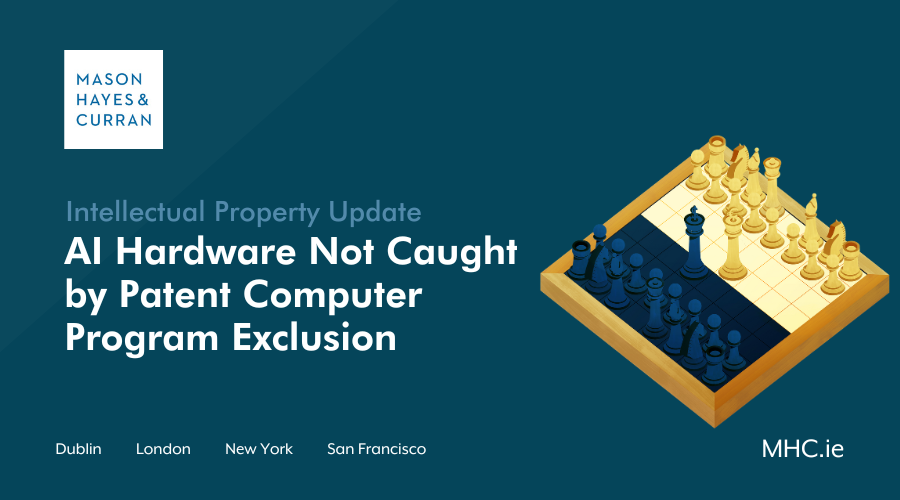AI Hardware Not Caught by Patent Computer Program Exclusion

In the first decision of its type, the High Court of England and Wales have considered whether an Artificial Neural Network engages the patent exclusion for a computer program. Our Intellectual Property team analyses the court’s findings that Emotional Perception’s Artificial Neural Network does not fall within the computer program patentable exclusion.
In Emotional Perception AI v Comptroller General of Patents[1], the High Court of England and Wales disagreed with a patent that claimed an Artificial Neural Network (ANN), a species of Artificial Intelligence, is a computer program. As a result, the proposed ANN patent does not violate the exclusion that it is “a program for a computer … as such”. We examine this decision and discuss the positive impact for inventors in the AI and machine learning space.
A computer program is not a patentable invention
Programs for computers are expressly excluded from patent protection, as set out in Section 1(2)(c) of the UK Patents Act 1977. The rationale for this exclusion lies in the fact that the subject matter for which patent protection is sought should be reserved to inventions that have technical character or technical teaching. Critically, the exclusion relates to computer programs “as such” and does not apply to inventions that have a technical character.
The approach of the UK courts to establishing what falls within the exclusion involves looking at whether the claimed invention makes a technical contribution to the known art. In other words, the invention is not patentable if the only technical contribution lies in excluded matter. A four-stage test for deciding whether the exclusion should apply has been established by the UK Court of Appeal in Aerotel Ltd v Telco Holdings Ltd[2]:
- Properly construe the claim – that is the court must consider the meaning and scope of the claim
- Identify the actual contribution, although at the application stage this might have to be the alleged contribution
- Ask whether it falls solely within the excluded matter
- If the third step has not covered it, check whether the actual or alleged contribution is actually technical
The proposed patent: a trained Artificial Neural Network
ANNs, also known as neural networks, involve machine learning. The proposed patent is described as an improved system for providing media file recommendations to an end user. The benefit of the patent compared to existing offerings is that it proposes music recommendations based on human perception and emotion. Hardware ANN contains nodes and layers in hardware form. A computer can also run software which enables the computer to emulate the hardware ANN.
Once the ANN training is complete, the ANN can analyse a received track, establish music which is semantically similar and then by finding tracks with similar physical coordinates or vectors can make recommendations. Essentially, this provides a curated experience for the end user.
The Hearing Officer’s decision: the Aerotel criteria
Regarding step one of the Aerotel criteria, the Hearing Officer defines the method described outlining the process by which the ANN is trained.
The contribution required under step two is in the training of the ANN, which analyses the physical properties of the file by pairwise comparisons of training files.
Applying steps three and four of the Aerotel criteria, the Hearing Officer did not consider that the emulated ANN could be decoupled from the software platform that supports it.
Emotional Perception challenged the Hearing Officer’s decision on the grounds that:
- There is no computer program
- If there is a computer program, the exclusion does not apply because the claim reveals a technical contribution
High Court’s decision
Whilst Mr Justice Mann accepted there is a computer program involved at the training stage he noted that the program was a subsidiary part of the claim. He was not persuaded by the argument that the emulated ANN operated at the same level from the underlying software on the computer. The judge reasoned that if the hardware ANN is not running a program, then neither is the emulation. On that basis the computer program exclusion did not apply.
In addition, the judge noted that the contribution provided by the proposed invention did have a technical effect.
Takeaway
An equivalent provision excluding computer programs under Irish law exists in Section 9 (2(c) of the Patents Act 1992. Given that the UK courts decisions tend to be persuasive it is likely that a similar result would be reached by the Irish courts.
Ultimately this is very positive news for inventors of potential machine learning patents. Once the legislative criteria that a patent is new, involves an inventive step and is capable of industrial application is met, inventors can avail of patent protection.
For more information and expert legal advice on how best to protect your intellectual property rights, please contact a member of our award-winning Intellectual Property team.
The content of this article is provided for information purposes only and does not constitute legal or other advice.
[1] [2023] EWHC 2948 (Ch)
[2] [2007] RPC 7
Share this:

Gerard Kelly SC
Partner, Head of Intellectual Property Law, Co-Head of Dispute Resolution
+353 86 820 8066 gkelly@mhc.ie

